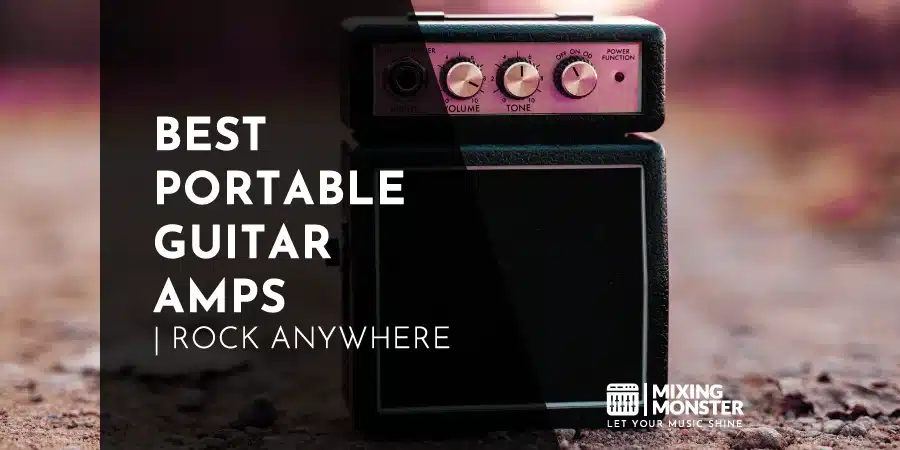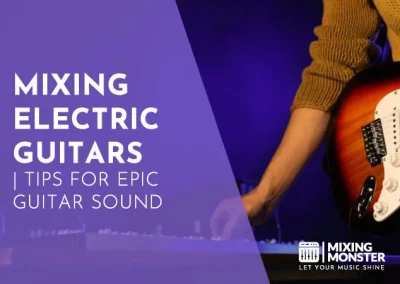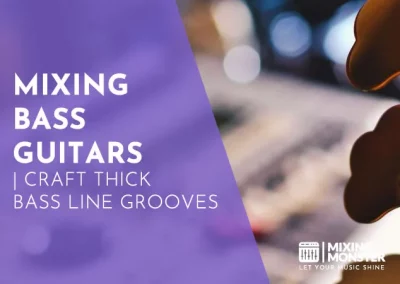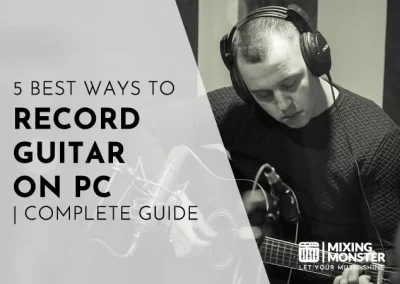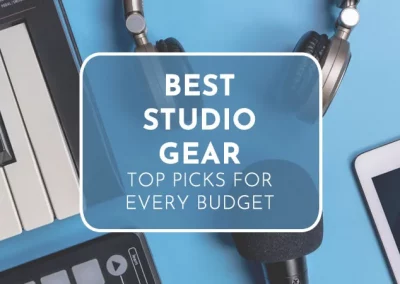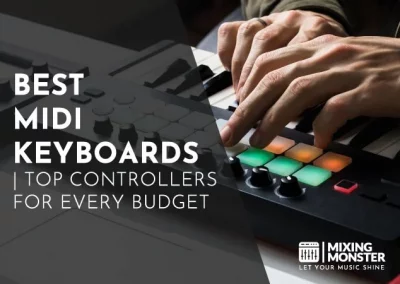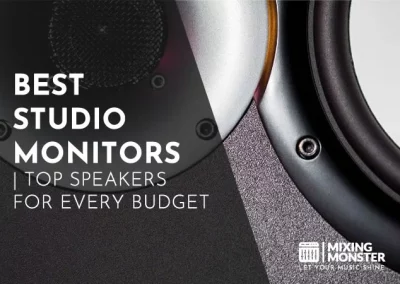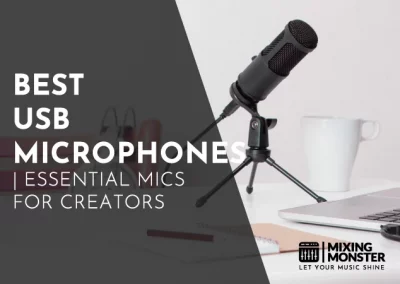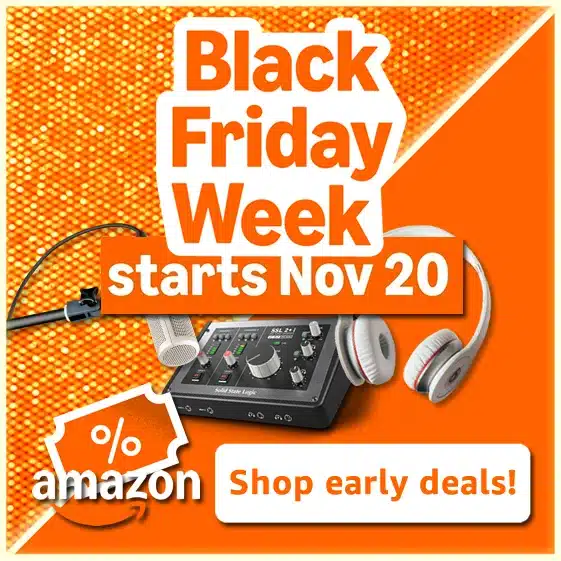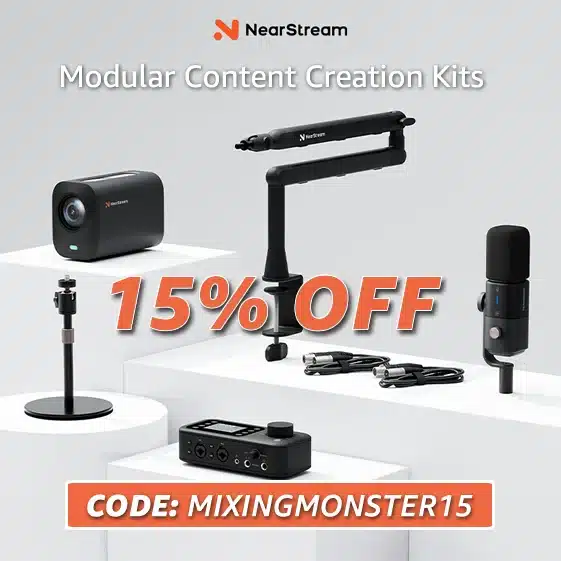Home > Blog > Music > Music Technology
Disclosure: Some of the links below are affiliate links, meaning that at no additional cost to you, we will receive a commission if you click through and make a purchase. Read our full affiliate disclosure here.
Portable guitar amps give you the freedom to play wherever you want—without losing sound quality. These compact amplifiers let guitarists roam, whether you’re busking, jamming with friends, or practicing in places where lugging a big amp just isn’t happening.
Portable guitar amps are lightweight, easy-to-carry systems that manage to produce enough volume and a decent tone for a range of situations. Some are tiny, battery-powered boxes under five pounds; others are a bit bigger and can handle small gigs. Most of these amps offer a mix of input choices, built-in effects, and rechargeable batteries for hours of play.
Picking a portable guitar amp? Battery life and power matter most—nobody wants to run out of juice mid-song, and you’ll want enough punch to be heard.
Weight, size, sound quality, and available effects all play a part, too. Lately, many of them come with Bluetooth, recording features, or even ways to connect your phone, which is quite handy.
We tested a variety of portable guitar amps to determine which ones truly strike the perfect balance of portability, tone, and reliability for guitarists on the go.
KEYNOTES:
- In this article, you’ll find a comprehensive list of the best portable guitar amps on the market.
- Portable guitar amps are categorized into 3 sections:
Best Budget Portable Guitar Amps
Best Midrange Portable Guitar Amps
Best High-End Portable Guitar Amps - Each section contains:
4-6 Portable Guitar Amps
ordered by price (low > high)
Our Top Picks – Best Portable Guitar Amps
Best Budget
Headrush
FRFR GO
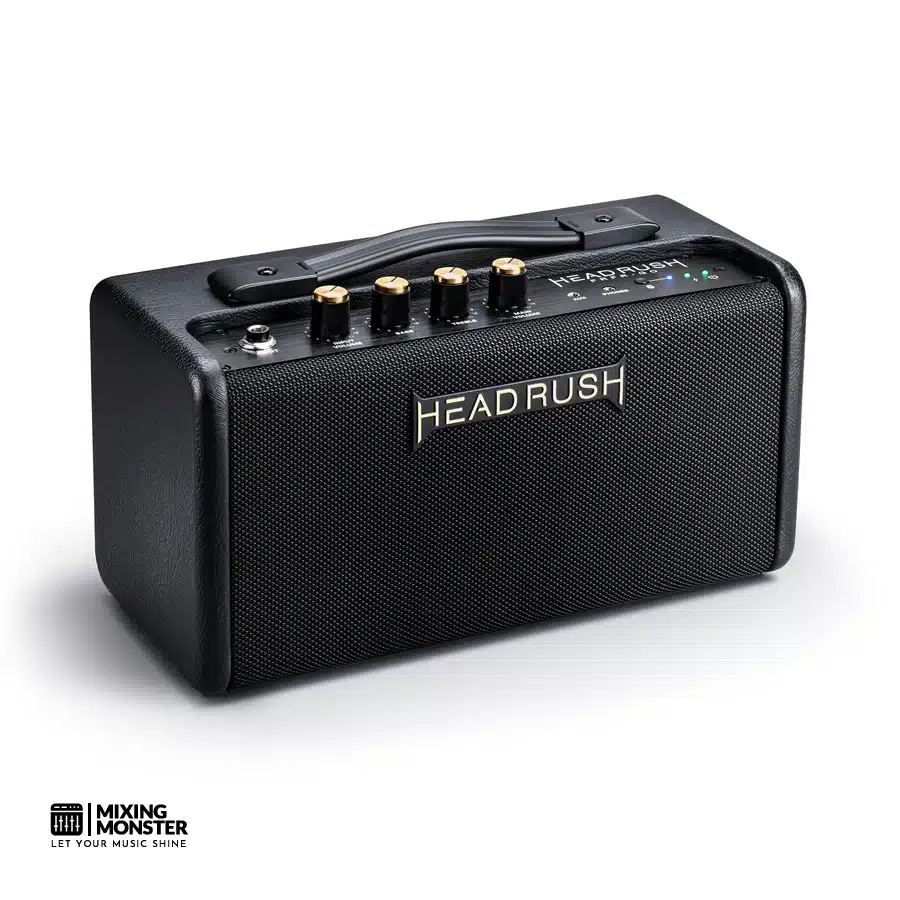
Best Midrange
Positive Grid
Spark 2 w/Battery Bundle
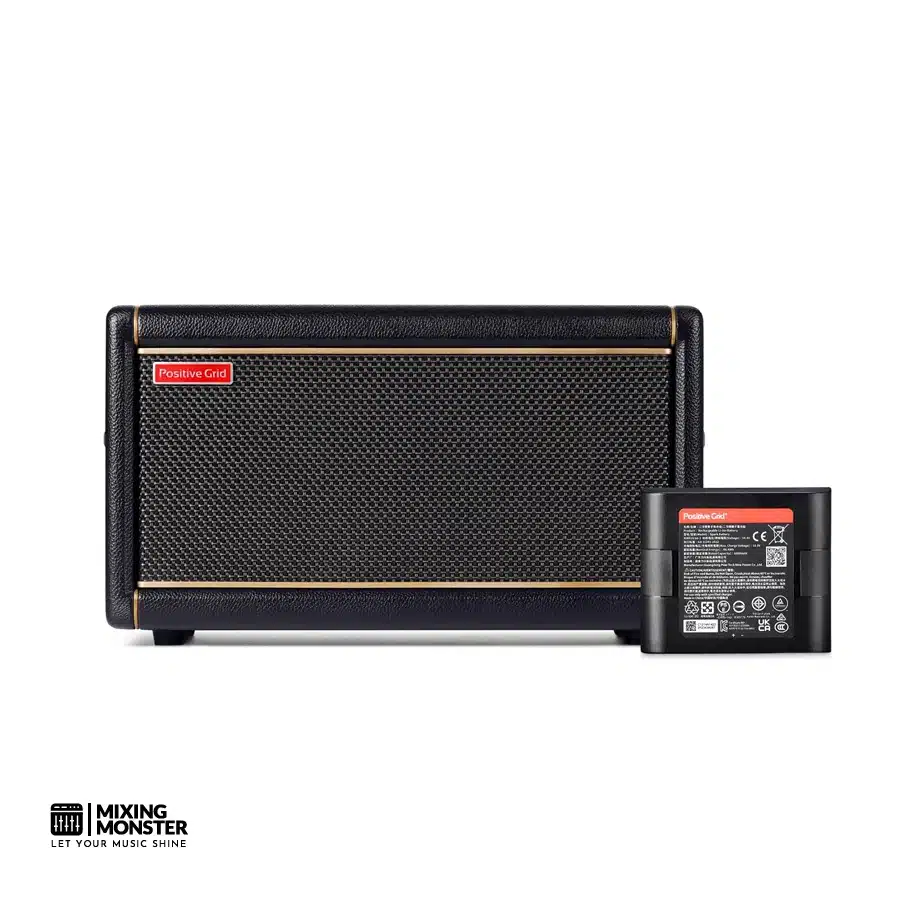
Best High-End
Roland
Cube Street EX
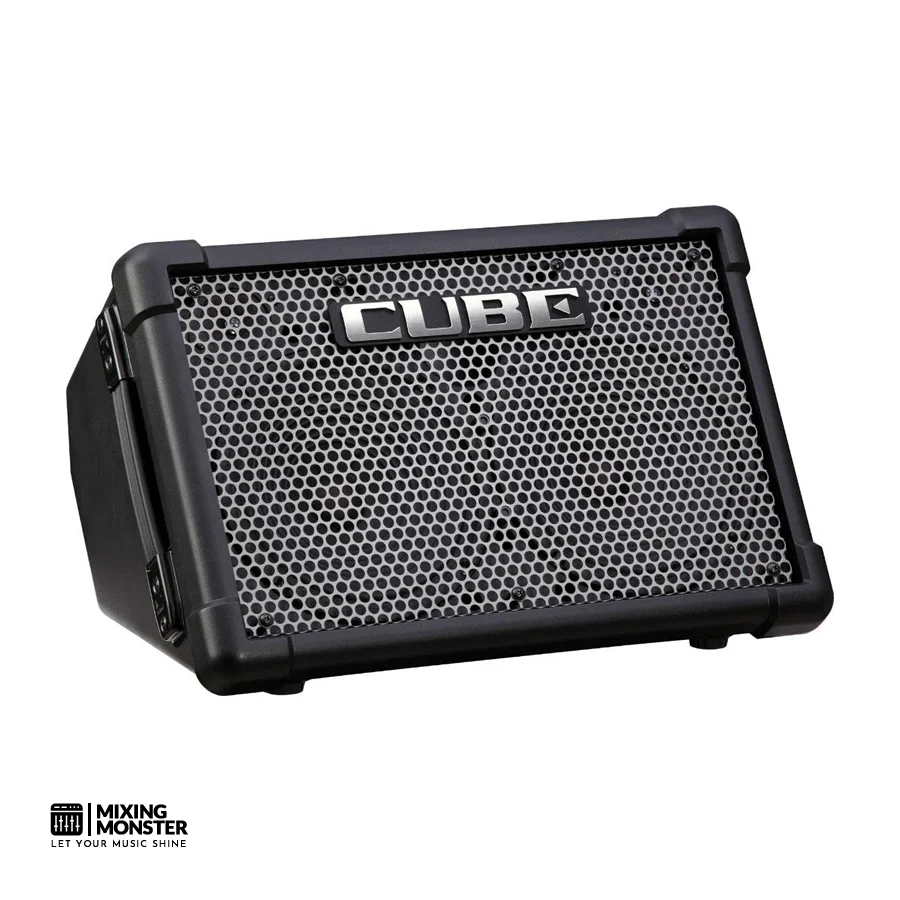
Table Of Contents
1. What Are The Best Portable Guitar Amps?
Best Budget Portable Guitar Amps
Best Midrange Portable Guitar Amps
Best High-End Portable Guitar Amps
2. What Is A Portable Guitar Amp?
3. Essential Accessories To Complement Your Portable Guitar Amp
4. Portable Guitar Amp Buying Guide
5. Finding Your Perfect Portable Guitar Amp: Key Takeaways
FAQ

1. What Are The Best Portable Guitar Amps?
Here’s our complete list of the best portable guitar amps you can grab right now. We checked each one for sound, portability, and battery life to help you pick the right amp for practice or even a small show.
Here Are Our Picks For The Best Portable Guitar Amps:
Best Budget Portable Guitar Amps
Best Midrange Portable Guitar Amps
8. Harley Benton StreetBox-60
Best For Street Performers Seeking Power And Portability
Best High-End Portable Guitar Amps

Best Budget Portable Guitar Amps
#1 Marshall MS-2
Best For Practice Sessions, Quiet Playing, and Travel Musicians
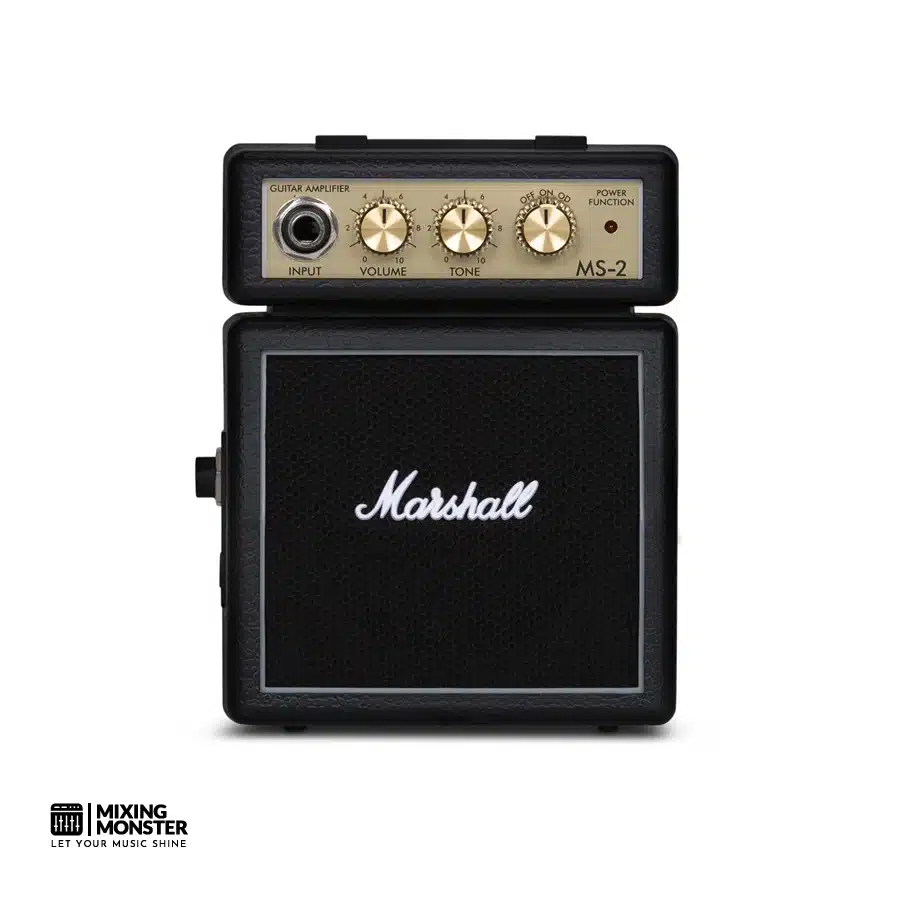
Overview:
The Marshall MS2 Micro Amp crams legit Marshall tone into a palm-sized box. It’s battery-powered and offers both clean and overdrive sounds, controlled by simple volume and tone knobs. We found it surprisingly punchy for its size—perfect for sneaky practice or jamming on the go.
Pros:
- Honest Marshall sound in a tiny package
- Switch between clean and overdrive
- Super portable, runs on batteries
Cons:
- A tiny speaker means you won’t get much bass
- Goes through 9V batteries pretty quickly if you use it a lot
- Not loud enough for group jams or gigs
Unique Selling Point:
The MS2 is wild—it squeezes classic Marshall vibes into something smaller than a lot of pedals, and still sounds like a Marshall.
Key Benefits:
- Silent Practice Capability – Plug in headphones, and you can practice late at night without disturbing anyone, while still maintaining decent tone control.
- Ultimate Portability – At just 12 ounces, you can toss it in any bag and forget it’s there until you need it.
- Authentic Marshall Tone – The overdrive channel actually gives you that crunchy Marshall sound, even though it’s tiny.
Pricing:
| Average Price | ~ $48 |
Review:
The MS2 surprised us with its sturdy feel and that classic Marshall look, just miniaturized. Plugging in, the clean channel is clearer than expected—though it can’t get super loud before it starts to break up. One watt is fine for practicing alone, but don’t expect to keep up with a drummer.
Switching to overdrive, you really get that Marshall crunch. The distortion’s squished, but it’s got the character you’d want for quick practice. Tone control’s simple but works—though, sure, more bass would be nice if it were possible from such a small speaker.
Running on battery is convenient, but it can become annoying if you play for an extended period of time. A fresh 9V lasted us a few sessions, but the volume drops off as the battery drains. Plugging in at home solves that, though.
The headphone jack is a lifesaver for late-night practice. It actually sounds fuller through headphones than through the speaker, which makes it perfect if you live with roommates or want to keep things quiet.
For the price, and for what it is, the Marshall MS2 is a fun little amp. Beginners, travelers, or anyone who wants that Marshall sound in their pocket will probably get a kick out of it.
#2 Orange Crush Mini
Best For Bedroom Practice, Backstage Warm-Ups, And Portable Jamming
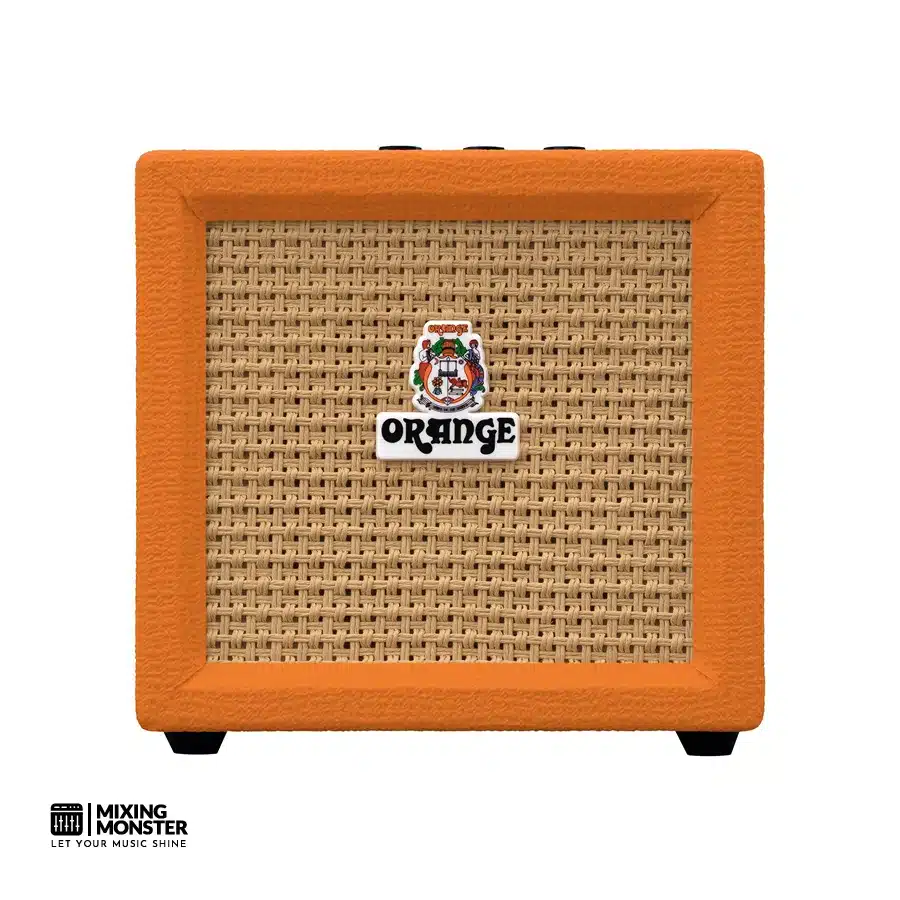
Overview:
The Orange Crush Mini brings that unmistakable Orange amp flavor in a size that’s compact enough to toss in your backpack. It’s a 3-watt beast (well, for its size) that’s great for quiet practice or travel. The simple three-knob panel is easy to use, but it offers a more tonal range than you’d expect. With a built-in tuner and headphone jack, it really covers the basics for practicing anywhere.
Pros:
- Classic Orange overdrive feel, mini-sized
- Built-in tuner—super convenient
- Speaker output lets you hook up a bigger cab if you want
- Runs on a 9V battery so that you can take it anywhere
- Feels solid—metal case and real tolex
Cons:
- Clean sounds start to break up if you crank it
- Not enough headroom for loud jams
- Batteries don’t last forever, especially if you push them
- No reverb or fancy effects
Unique Selling Point:
The Crush Mini features genuine Orange preamp guts and a speaker output, allowing you to use it as a practice amp or as a preamp for a larger cabinet. That’s not something you see every day at this size.
Key Benefits:
- Authentic Orange Tone – You get that gritty, punchy Orange drive, just in a smaller package
- Ultimate Portability – Battery-powered and tiny, so you’re never stuck without an amp
- Versatile Connectivity – Plug in headphones, hook up to a cab, or use the aux—lots of options for different situations
Pricing:
| Average Price | ~ $79 |
Review:
The Crush Mini looks and feels like a real Orange amp, just shrunk down. The tolex and metal chassis give it a more expensive feel than it actually is. We doubt it’d have that signature Orange sound, but it actually does.
The three knobs are straightforward to operate. Roll back the gain and turn up the volume for clean-ish tones; the shape control lets you tweak the mids for either scooped or fat sounds.
Push the gain up and you get surprisingly thick, saturated overdrive—very Orange. The amp responds well to your playing and even to the volume knob on your guitar. Just don’t expect pristine cleans at higher volumes; it starts to break up pretty early.
Battery life’s not bad. One 9V battery got us through several sessions before it started to fade. The built-in tuner is a nice touch, but it stops working when the battery is low. The headphone jack is excellent, allowing you to practice quietly, and it completely mutes the speaker.
What really sets this amp apart is the speaker output. We plugged it into a 1×12 cab and, honestly, it was like having a mini Orange head. It gets way louder and fuller that way. This makes it a solid investment for anyone seeking a practice amp that can also serve as a backup for small gigs or rehearsal spaces.
The Orange Crush Mini truly delivers on its promise: a genuine orange tone in a compact, durable package. It’s not a replacement for a full-size amp, but for practice and emergencies, it’s a winner.
#3 Blackstar FLY 3 Mini Amp
Best For Practice Sessions, Bedroom Playing, And Travel Musicians

Overview:
Blackstar’s FLY3 packs a surprising punch for such a tiny, 3-watt, just-over-a-pound amp. You get two channels, digital tape delay, and that nifty ISF control for dialing in your favorite tones. It runs on six AA batteries or a power adapter, which is a lifesaver if you want to practice anywhere. The sealed cabinet does a good job of mimicking the low-end of larger wooden amps, even though it’s made of plastic.
Pros:
- Full-range driver gives it an impressive tone for its size
- Super portable at 1.1 pounds and battery-powered
- Delay effect and ISF control make it pretty versatile
- Sealed cab delivers better bass than you’d expect
- Two channels—switch between clean and overdrive
Cons:
- It chews through batteries if you play loud or long
- Not enough output for jamming with a full band
- Plastic shell just isn’t as nice as wood
- No tuner or extra effects besides delay
Unique Selling Point:
The FLY3‘s ISF control is the real standout—you can blend between American and British amp vibes, which is wild for something this small.
Key Benefits:
- Superior Sound Engineering: The full-range driver keeps guitar tone intact—no crossover weirdness—so you actually get clarity you’d expect from monitors, not a mini amp.
- Ultimate Portability: Light, battery-powered, and toss-it-in-your-bag ready. You’re not stuck to a wall outlet, so practice wherever the mood strikes.
- Professional tone shaping: ISF and delay let you tweak and play with your sound in a way that rivals much bigger amps.
Pricing:
| Average Price | ~ $84 |
Review:
The FLY3 made a great first impression—feels solid for a little amp, and the controls are proper where you’d want them. The clean channel’s got more headroom than we expected, and the overdrive actually sounds pretty musical, not just buzzy or boxy.
That ISF control? It’s not just a gimmick. You can really sweep from a bright, snappy American sound to that thicker British midrange. The tape delay is a fun touch too—adds some lovely space without turning everything to mush.
Battery life is decent for practice, but if you crank it or use a lot of delay, you’ll run through AAs faster than you’d like. The sealed cab genuinely surprised us—it’s got a bit of thump, not just thin highs. Most small amps sound tiny; this one avoids that.
Volume-wise, it’s perfect for practicing at home or in a small room. You get enough sound to enjoy playing, but if you’re thinking of jamming with a drummer, forget it. Switching between channels on the FLY3 is quick and easy, allowing you to transition from clean to dirty mid-song without a fuss.
Build quality lands about where you’d expect for the price. The knobs feel solid, and nothing’s loose or flimsy. Sure, the plastic isn’t fancy, but it keeps things light and portable. Honestly, we’d rather have a better tone than a wooden box at this price.
#4 Headrush FRFR GO
Best For Amp Modeler Users, Home Practice, And Portable Sessions

Overview:
The HeadRush FRFR-GO delivers honest, full-range, flat-response sound in a compact desktop amp. It’s got 30 watts and dual 3-inch speakers, so your amp modelers and pedals sound just like they should—no weird coloration. We’d say it’s kind of the missing link between a studio monitor and a practice amp, honestly. The built-in battery lasts up to 13 hours, allowing you to set up anywhere and play without interruption.
Pros:
- Battery lasts all day—seriously impressive
- Doesn’t color your modeling tones at all
- Bluetooth for jamming along to tracks
- Quick recharge—about three hours
- Easy to carry with the handle
Cons:
- Not loud enough for big rooms or group jams
- It’s a bit heavy if you carry it around a lot
- Bass is a little lacking for lower tunings
- Costs more than basic practice amps
Unique Selling Point:
The FRFR-GO is all about giving modeling pedal users studio-quality sound anywhere—true flat-response in a package you can actually move around.
Key Benefits:
- Wireless Freedom – The battery means you’re not hunting for outlets. Please take it to the patio, the living room, or wherever you prefer.
- Authentic Tone Reproduction – Unlike regular guitar amps, this device lets your pedal’s amp and cab sims shine—no added color, just what you programmed.
- Versatile Connectivity – Bluetooth, aux, direct pedal hookup—it’s ready for whatever practice setup you’ve got.
Pricing:
| Average Price | ~ $149 |
Review:
We ran the FRFR-GO with a handful of modeling pedals, and it just nails what modeler folks want. Helix patches sounded just like they do on studio monitors, but now we could toss the amp on a desk and not worry about cables everywhere.
The battery outperformed my expectations. We managed to get through a whole weekend’s worth of noodling without even thinking about charging. The LED battery indicator is a thoughtful touch—no guessing how much juice is left. Bluetooth worked great for backing tracks, and we didn’t notice any lag.
It’s a real step up from regular practice amps. Where those tend to mess with your tone, this one keeps everything honest. The dual speakers handled everything from cleans to heavy gain, although we did notice a slight compression if I really pushed the volume.
Portability of the FRFR-GO is mostly great, though at 7.4 pounds, it’s not feather-light if you’re lugging it around all day. The small speakers also mean you won’t get deep bass, especially with baritone or 7-string guitars. The volume is suitable for home use, but don’t expect to fill a hall.
The build feels sturdy—metal and plastic are used in the right places. It’s nice to handle, with controls that are responsive and straightforward to use. We liked having simple EQ tweaks on the amp instead of digging into pedal menus.
#5 Roland Mobile Cube
Best For Musicians Seeking Battery-Powered Acoustic Performance
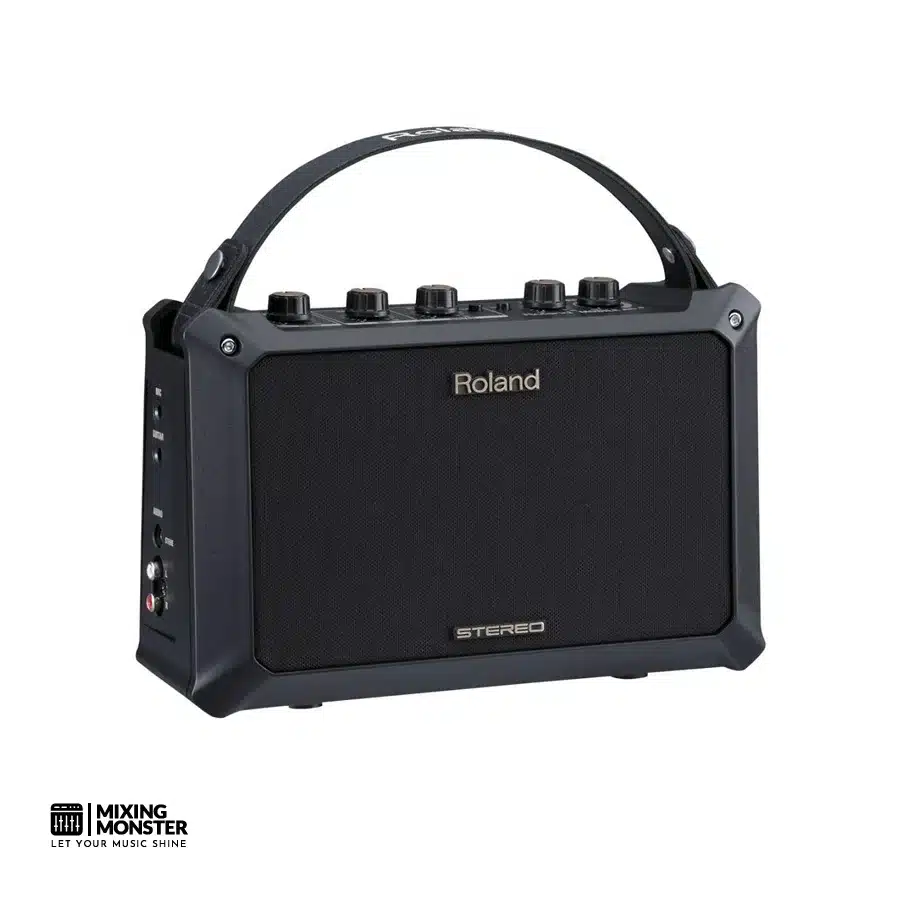
Overview:
Roland’s Mobile-AC is all about clean, portable acoustic amplification. It’s a stereo amp that really surprised us with how open and natural it sounds for its size. Six AA batteries will keep it running for up to 15 hours, allowing you to play anywhere. Built-in chorus and reverb effects add some nice color without washing out the guitar’s tone.
Pros:
- 15-hour battery life—great for outdoor or unplugged sessions
- Stereo sound keeps your acoustic tone feeling real
- Light enough to throw in a backpack
- Takes guitar, mic, and media player inputs
- Chorus and reverb effects onboard—no pedals needed
Cons:
- It’s not loud enough for big rooms or noisy spaces
- Plastic build isn’t as tough as metal
- Six AA batteries add up in cost over time
- Not much in the way of advanced tone controls
Unique Selling Point:
The real draw of the Roland Mobile AC is the 15-hour battery and the stereo acoustic optimization. If you need reliable, natural-sounding acoustic amplification off the grid, this is hard to beat.
Key Benefits:
- Extended Battery Performance – Play all day, inside or out, without worrying about outlets.
- Authentic Acoustic Reproduction – Our stereo setup and voicing preserve your guitar’s character.
- Complete Portability – Lightweight and battery-powered; grab it and go.
Pricing:
| Average Price | ~ $191 |
Review:
Plugging in an acoustic guitar, the Mobile-AC instantly delivered a clean, natural sound. The stereo field makes it feel bigger than it looks. We liked that it didn’t mess with the guitar’s tone—just amplified it nicely.
Battery life holds up; We were able to get through long outdoor jams without worrying about running out of power. The battery indicator is a brilliant addition—no surprises mid-session.
Sound quality is the star here. The chorus is subtle but adds depth, and the reverb is tasteful—never gets swampy. We tried several acoustics with the Roland Mobile-AC and consistently achieved a clear, even sound in small rooms and outdoors.
Volume is where you hit the limit. Five watts is plenty for solo practice or a quiet coffeehouse, but it can’t keep up with a band or fill a big space. For what it’s built for, though, it’s spot on.
The plastic build keeps it light, but we wouldn’t want to drop it off a stage. It handled everyday travel just fine, but we wouldn’t call it road-tough.
Best Midrange Portable Guitar Amps
#6 Positive Grid Spark Mini
Best For Bedroom Practice, Travel Musicians, And Tech-Savvy Guitarists
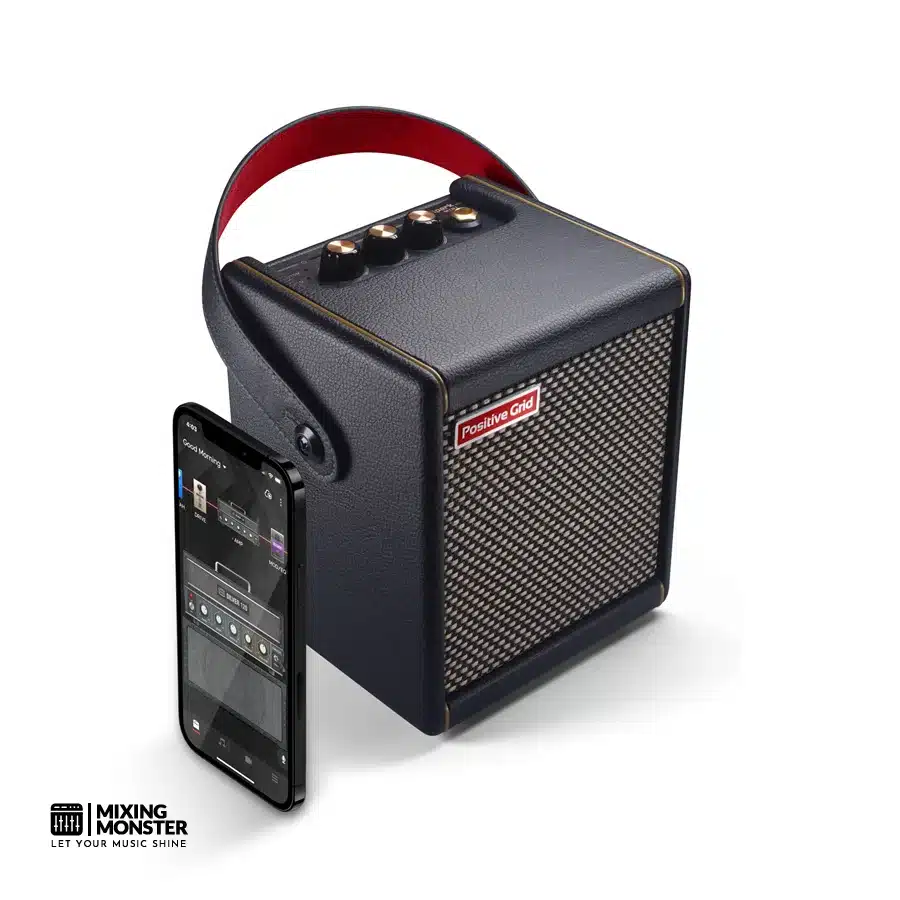
Overview:
Positive Grid’s Spark MINI combines a 10-watt guitar amp with Bluetooth speaker capabilities in a compact design. We got hands-on with it and discovered it unlocks a massive range of tones via its app, plus those AI-driven backing tracks are a blast. Its battery lasted us nearly 8 hours, which is plenty for most practice binges.
Pros:
- Smart Jam Live creates backing tracks that actually adapt to how you play
- Over 50,000 community presets—yeah, you’ll never get bored
- Works as both a legit guitar amp and a surprisingly good Bluetooth speaker
Cons:
- You’ll need your phone to access most features
- Not many physical controls, so you’ll be on the app a lot
- Costs more than basic amps that skip the smart features
Unique Selling Point:
The Spark Mini’s AI-powered Smart Jam Live listens to your playing and instantly cooks up bass and drum tracks to match. It’s almost spooky how well it works sometimes.
Key Benefits:
- Portability – Tiny size and a built-in battery mean you can practice anywhere, no wall plug needed
- Tone Flexibility – Loads of pro amp models and effects, so you can dial in whatever vibe fits your mood
- Interactive Practice – Smart backing tracks and chord recognition keep solo practice from feeling lonely
Pricing:
| Average Price | ~ $199 |
Review:
We put the Spark MINI through its paces, and it combines grab-and-go convenience with surprisingly good sound. The first thing that jumped out at us was the tone. For something this small, it cleans sound crisp and detailed, and even the gainier stuff holds together without turning to mush.
Smart Jam Live? That’s the party trick. We incorporated chord progressions and single-note riffs, and the AI-generated backing tracks felt musical and actually enjoyable to play with. The drums groove along, the bass lines fit, and suddenly you’re not just practicing—you’re jamming.
Setting up is painless, but you really need the app to access all the good stuff. Luckily, the app’s easy to navigate, and the endless user tones from all sorts of genres kept us exploring way longer than planned. The community vibe adds a lot—there’s always something new to try.
Battery life was right in line with what they claim, at least for us. We squeezed out nearly 8 hours at moderate volume. The USB audio interface worked seamlessly with our DAW, making it convenient for both home recording and professional use. As a Bluetooth speaker, it’s more than solid for casual listening.
Biggest gripe? You’re reaching for your phone a lot—even for simple things like switching tones. More knobs or buttons would help. Still, if you want a smart, portable amp with authentic tone cred, the Spark MINI‘s tough to beat.
#7 Yamaha THR5A
Best For Desktop Practice And Home Recording
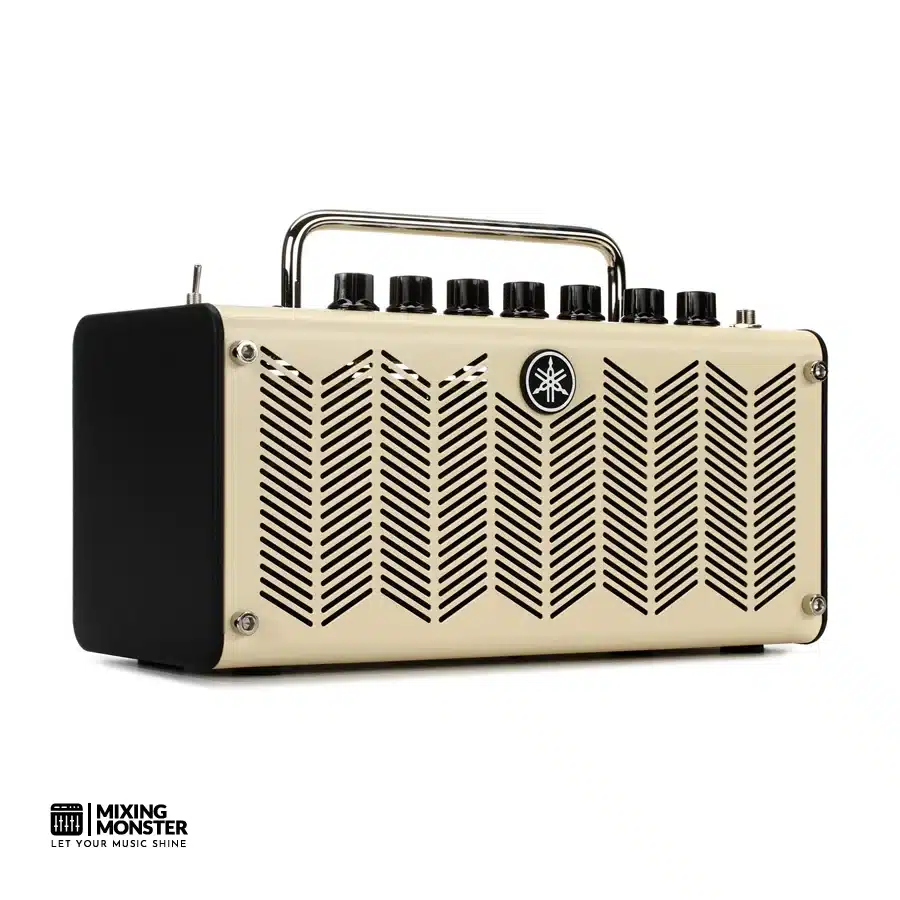
Overview:
The Yamaha THR5 delivers big sound in a compact, desktop-friendly package. This 10-watt combo features five classic amp models utilizing Yamaha’s VCM technology, along with built-in effects and stereo output. It runs on AC or AA batteries, allowing you to take it anywhere—from the living room to the backyard. The hi-fi stereo setup gives it a leg up on most little amps.
Pros:
- Rich, full sound that punches above its size
- Truly portable with battery or wall power
- Built-in USB for recording and editing
- Plenty of amp models and effects for any mood
- Fits just about anywhere—tiny desk footprint
Cons:
- Batteries drain faster than you’d hope if you play a lot
- Doesn’t get loud enough to hang with a full band
- Costs more than your average practice amp
- The plastic shell doesn’t feel as tough as metal
Unique Selling Point:
The THR5‘s stereo sound is a cut above—Yamaha’s AV team helped design it, so it sounds more like a hi-fi system than a practice amp.
Key Benefits:
- Studio-Quality Tone: VCM modeling accurately captures the feel and response of classic amps, down to how they react to your picking and guitar volume.
- Ultimate Portability: Batteries and a lightweight build mean you can set up wherever inspiration hits—no need to hunt for outlets.
- Recording Integration: USB allows you to record directly to your computer, and the editor software provides you with sufficient control to shape your sound.
Pricing:
| Average Price | ~ $249 |
Review:
The THR5 wowed us right out of the box. Plug in, and you get warm, detailed cleans and crunchy overdrive without that weird digital harshness cheaper amps sometimes have. The stereo speakers really open things up—you hear your playing in a wider space, which makes practicing a lot more fun.
We used batteries for a while, but the AC adapter has become our go-to since the amp chews through batteries during extended sessions. Still, it handled both single-coil and humbucker pickups without losing clarity. The built-in reverb and delay? Surprisingly natural and musical, not fake or tinny.
Although it’s made of plastic, the amp feels sturdy enough for most uses. The knobs turn smoothly, and the LEDs are bright and easy to spot. Being able to park it on a crowded desk is a real plus if you’re short on space.
Recording via USB provided us with clean, mix-ready tracks with minimal fuss. Direct monitoring meant no annoying latency. The software isn’t fancy, but it gets the job done for tweaking tones and saving presets.
If you want a desktop amp that sounds significantly larger than it appears and doubles as a handy recording tool, the THR5 is a solid choice.
#8 Harley Benton StreetBox-60
Best For Street Performers Seeking Power And Portability
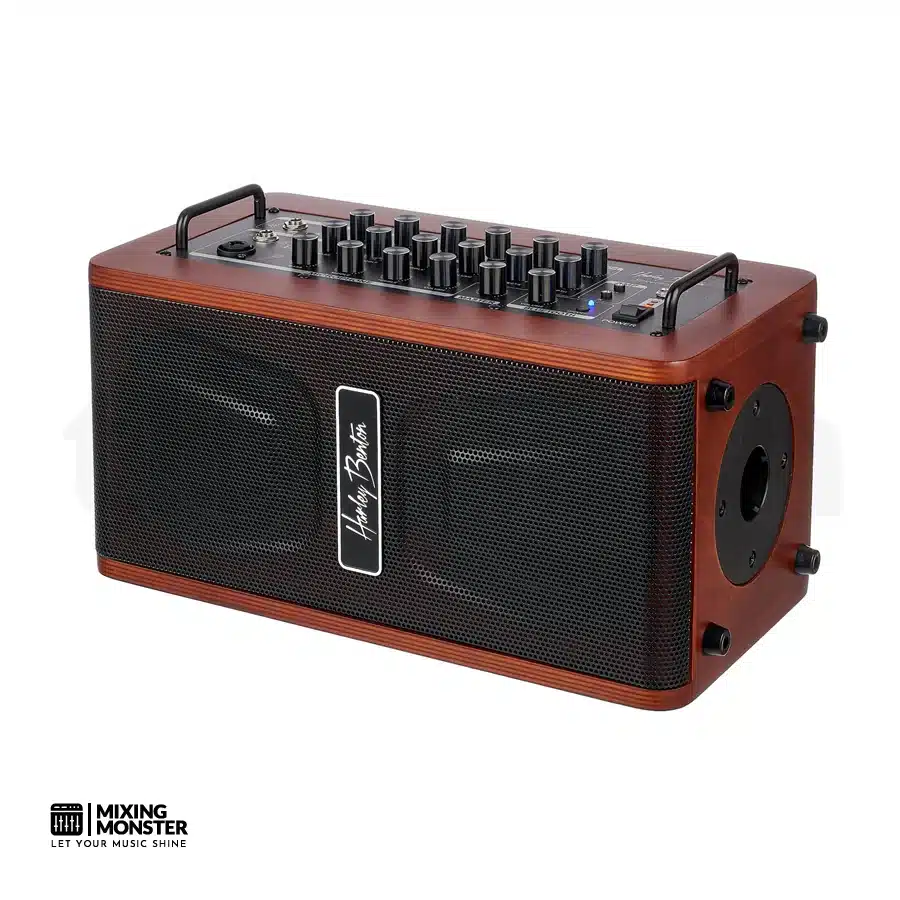
Overview:
We’ve spent a lot of time with the Harley Benton StreetBox-60. It’s easy to see why so many mobile musicians love it.
Harley Benton designed this amp for performers who need a reliable, battery-powered rig. The StreetBox-60 kicks out impressive sound projection and tonal clarity for its size.
Its dual-channel setup works well for both guitar and vocals. The rugged design handles the bumps and scrapes of outdoor gigs without a fuss.
If you’re always on the move, this amp finds a sweet spot between portability, power, and price—honestly, not many amps pull that off.
Pros:
- Dual-channel design for instrument and mic inputs
- Strong battery life suitable for long sessions
- Clear, balanced tone with solid low-end presence
- Sturdy build quality is ideal for outdoor use
- Great value for the performance offered
Cons:
- Slightly bulky compared to smaller portable amps
- Limited built-in effects
- Battery charging time could be faster
- Lacks Bluetooth connectivity
Unique Selling Point:
The Harley Benton StreetBox-60 stands out for its dual-channel versatility. You can plug in both guitar and microphone at the same time, and it still holds up with clean, powerful output—even when you’re running on battery.
Key Benefits:
- Versatility: The dual input channels make it perfect for solo performers who sing and play guitar.
- Powerful Output: Despite its compact design, it delivers enough volume for small gigs and street performances.
- Durability: The robust housing ensures long-term reliability in outdoor environments.
Pricing:
| Average Price | ~ $311 |
Review:
The Harley Benton StreetBox-60 impressed us from the start with its rugged, gig-ready design. The power output is honestly surprising for something this portable.
We took it out for plenty of outdoor tests. It held up, delivering clear, articulate sound without any real distortion—even when we cranked the volume.
The dual-channel layout was particularly helpful for street performing. We could run a guitar and a microphone simultaneously, each with its own controls, which made life easier.
Battery performance? Pretty solid. We squeezed out several hours of playtime before it needed a recharge, though I wish charging were quicker.
Sure, there’s no Bluetooth or fancy onboard effects, but the simplicity actually feels refreshing. It’s for musicians who want something reliable and straightforward, not a toy box of features.
Transporting it was a breeze.
The handle and reasonable weight of the StreetBox-60 made setup and teardown quick, which is particularly important when you’re always on the move.
During our tests, it shrugged off some light rain and dust. That durability claim isn’t just marketing fluff, in my experience.
#9 Positive Grid Spark 2 w/Battery Bundle
Best For Musicians Seeking AI-Enhanced Practice Sessions

Overview:
The Positive Grid Spark 2 + Battery Bundle mashes up a 50-watt smart amp with wireless freedom and AI-powered tone matching. We spent some real time with it and got rich sounds from the angled FRFR speakers, plus creative perks like built-in drum patterns and looping.
The battery pack handled up to 12 hours of unplugged play for us. Sonic IQ Computational Audio technology brings out a wealth of detail and clarity, and the app offers a vast range of tone tweaks for electric, acoustic, and bass instruments.
Pros:
- 12-hour battery life means you can play all day, anywhere
- AI tone matching creates custom sounds from just a description
- Groove looper and deep drum pattern library make solo practice feel like a jam session
Cons:
- AI features can be hit or miss and take time to master
- Footswitch isn’t included—add that to the price if you want hands-free
- Plastic build doesn’t exactly scream “premium” at this price
Unique Selling Point:
The Spark 2‘s AI-driven tone creation is impressive: you describe the sound you want, and it selects a preset using computational audio. Sometimes it hits the mark, sometimes not, but it’s always interesting.
Key Benefits:
- Wireless Freedom – The battery lets you set up shop wherever, with no cords or outlets to worry about
- Creative Enhancement – Drum patterns and looping make solo jams feel like a full band’s in the room
- Smart Connectivity – The app hooks you up with tons of tones and lets you play along with streaming tracks
Pricing:
| Average Price | ~ $428 |
Review:
We gave the Spark 2 a thorough workout and found it to be one of the most flexible amps for today’s guitarists. The 50-watt punch is more than enough for home use, and the FRFR speakers fill the room without compromising clarity at lower volumes.
The battery outperformed our expectations—we hit the 12-hour mark on moderate use, and charging wasn’t a hassle. You can keep playing while it’s plugged in, so you’re never really stuck waiting.
AI tone matching is both the amp’s party trick and its Achilles’ heel. Sometimes, asking for a “warm blues tone” or “a crunchy rock sound” can get you exactly what you hoped for. At other times, it misses, and you’ll have to adjust things yourself. Still, when it works, it’s magical.
The looper and drum patterns really changed up our practice routine. Laying down rhythm parts and soloing over them felt intuitive, and the drum grooves kept things fresh. Patterns that sync automatically with your loops? Super handy.
The app’s fast and easy to use once you’re connected, and having instant access to a huge tone library is a big plus. Jamming along with streaming tracks is seamless.
Only catch: you’ll want your phone close by for the best experience, which might bug some folks.
For players who want a cutting-edge practice amp that’s packed with smart features—and don’t mind a little trial and error with the AI—the Spark 2 is a seriously cool option.
Best High-End Portable Guitar Amps
#10 Boss Katana Air EX
Best For Guitarists Seeking Wireless Freedom And Desktop Convenience
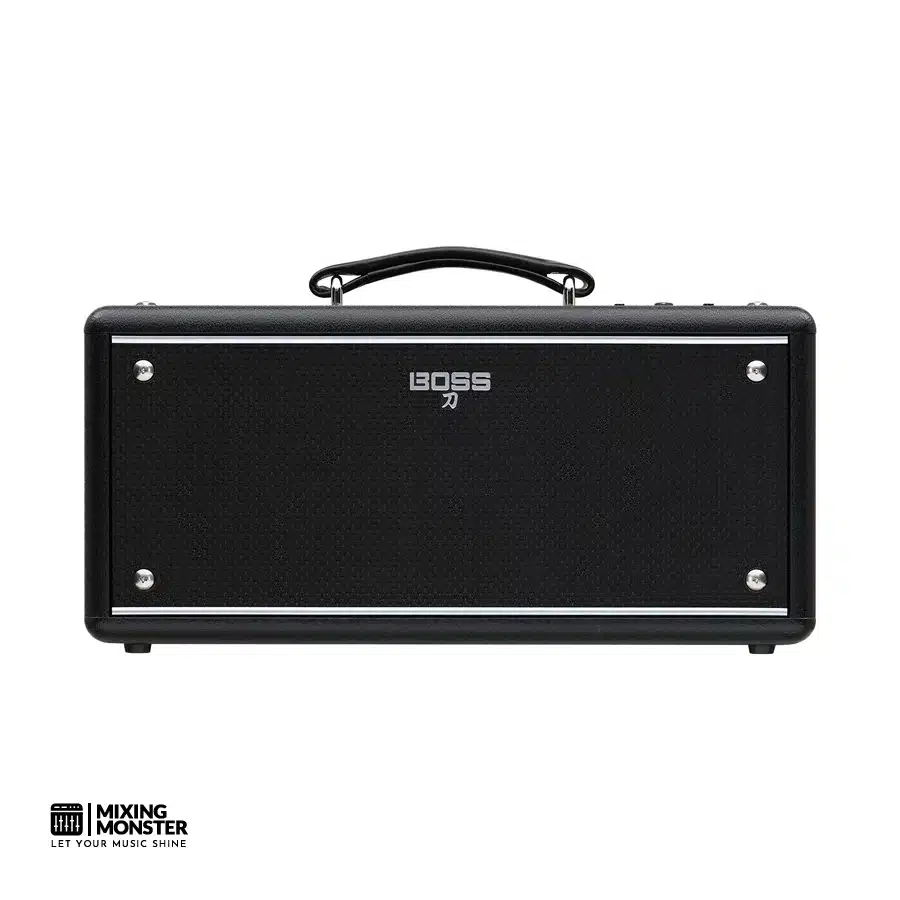
Overview:
The BOSS Katana-Air EX brings wireless guitar amplification to the desktop, featuring dual five-inch speakers housed within a wooden cabinet.
This amp delivers 35 watts and allows you to ditch the cables, thanks to its advanced wireless setup.
We found it to be quite versatile for guitar, bass, and acoustic-electric instruments, and the onboard effects and amp modeling cover a wide range of options.
Pros:
- Wireless connectivity—practice without getting tangled up
- Rich stereo sound from a wooden dual-speaker enclosure
- Loads of effects and amp models to play with
- Mobile app opens up deep sound customization
- Handles guitar, bass, and acoustic-electric instruments
Cons:
- Costs more than basic practice amps
- Battery life needs attention for longer jams
- Sound might not wow tone purists
- Pretty big for a “desktop” amp—doesn’t travel light
Unique Selling Point:
The Katana-Air EX truly shines with its low-latency wireless technology, enabling you to move freely around your practice space without tripping over cords.
Key Benefits:
- Wireless Freedom: You’re not anchored by cables, so practice feels a lot more relaxed and dynamic.
- Versatile Sound Options: It’s not picky—guitars, basses, acoustic-electrics all get their own amp characters.
- App Integration: The BOSS Tone Studio app gives you way more control and practice features than the physical knobs alone.
Pricing:
| Average Price | ~ $599 |
Review:
We put the Katana-Air EX through its paces, and honestly, it excels in the wireless aspect while maintaining its status as a solid desktop amp.
Those dual five-inch speakers produce a surprisingly large sound for this class, and the wooden cabinet lends it a warmth that you don’t get from plastic boxes. Setting up the wireless connection took just a minute, and we didn’t experience any dropouts or lag during normal use.
The amp models cover the basics—five main characters. Clean tones sound good, although you’ll want to tweak them slightly for optimal clarity. Distorted sounds have enough bite for practice, but they’re maybe not as crisp as some folks would hope.
The neutral amp setting for acoustic-electrics worked well, especially with piezo pickups—no weird coloring or harshness.
Battery power is a real plus for moving around or quick setups. We squeezed out several hours on four AAs, but if you’re planning a marathon session, keep some extras handy. The wireless range is more than enough for most rooms, and being able to walk around without cables genuinely changed how we practiced.
The effects section ticks most boxes—delays and reverbs stood out, though if you’re a die-hard pedal person, you might still want your own. The BOSS Tone Studio app is a significant upgrade over using the amp’s knobs alone, allowing you to explore settings that you might otherwise overlook. Bluetooth for backing tracks worked flawlessly.
Build-wise, it feels like a BOSS—solid, not too heavy for a desktop, and the wooden cab adds a nice touch. We didn’t encounter speaker buzzing, but we’ve heard it can occur with some units.
If you care more about convenience and features than chasing the “perfect” tone, the Katana-Air EX is a great pick for practice and home jamming.
#11 Yamaha THR30IIW
Best For Musicians Who Want Studio-Quality Tones With Complete Wireless Freedom
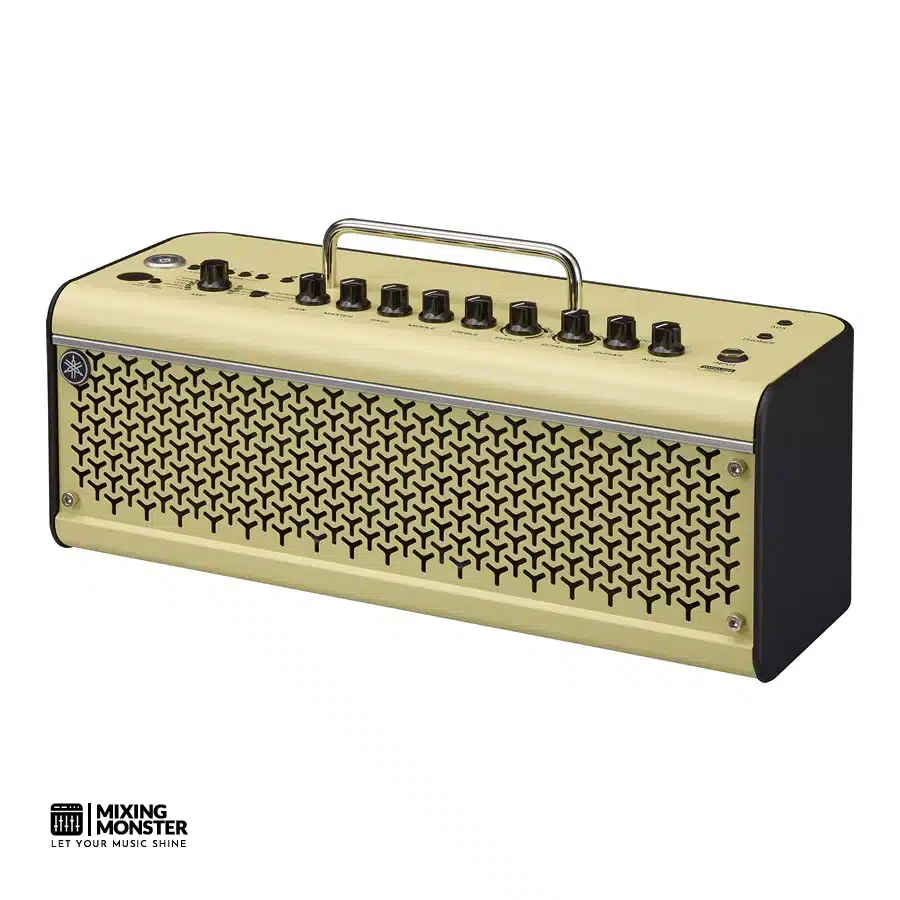
Overview:
The Yamaha THR30II Wireless sits at the top of the desktop amp game, delivering convincing tube-amp sounds in a compact, battery-friendly package.
We found these 30-watt amp packs in 15 guitar amps, three bass models, and acoustic-electric support. The built-in wireless receiver and Bluetooth free you from the usual cable mess.
Rechargeable battery and stereo outs make it flexible for both woodshedding and recording.
Pros:
- Built-in wireless and Bluetooth streaming—super convenient
- Tones rival much bigger (and pricier) tube amps
- The battery lasts long enough for real practice sessions
- Models for guitar, bass, and acoustic-electric instruments
- USB lets you record directly with pro results
Cons:
- Pricey compared to entry-level practice amps
- Some folks have had power reliability issues after a while
- External pedals don’t always play nice with every amp model
- At nearly 12 pounds, it’s heavier than you might expect for a portable
Unique Selling Point:
The THR30II Wireless is likely the first desktop amp to achieve true wireless freedom—utilizing Line 6 receiver technology and Bluetooth, so you’re completely untethered.
Key Benefits:
- Complete Wireless Freedom – Play wherever you want, no cables, thanks to the built-in wireless and rechargeable battery.
- Professional Sound Quality – Realistic tube-amp tones and high-quality audio, whether you’re practicing or recording.
- Multi-Instrument Versatility – Flip between guitar, bass, acoustic-electric, or even synths with the right amp models and flat modes.
Pricing:
| Average Price | ~ $599 |
Review:
The Yamaha THR30II Wireless made a strong first impression—its build quality feels top-notch, and the feature list is genuinely impressive. Yamaha continues to raise the bar for desktop amps, and this one takes it a step further with wireless technology. The tube-amp models sound shockingly close to the real thing, especially the Mesa-style high-gain and Fender cleans we tried.
Wireless worked just as advertised. We paired it with a Line 6 G10T and had no dropouts in the normal range. Bluetooth streaming for backing tracks and the THR Remote app both worked smoothly, so it’s easy to tweak tones or jam along with songs. Not being tied to a spot by cables is just more fun, plain and simple.
The sound quality? Genuinely impressive for a small box. The new enclosure gives it more bass punch than the old THRs. Acoustic-electric and bass models do their jobs well—mic modeling and bass amp sims sounded convincing enough for practice and some light gigging.
Battery life held up well for our longer sessions, although the weight might be a surprise if you’re considering tossing it in a backpack. USB recording straight into our DAW was seamless—no extra gear needed, which is a relief.
We’d heard about some long-term reliability issues with power, but our unit didn’t experience any problems. The THR Remote app is basically required to get the most out of this amp, and it’s worth using—wireless editing is a real advantage, not just a gimmick.
If you’re looking for a desktop amp that sounds authentic, works wirelessly, and covers a wide range of sonic territory, the THR30II Wireless should be on your shortlist.
#12 Roland AC-33
Best For Acoustic Guitarists Needing True Portability
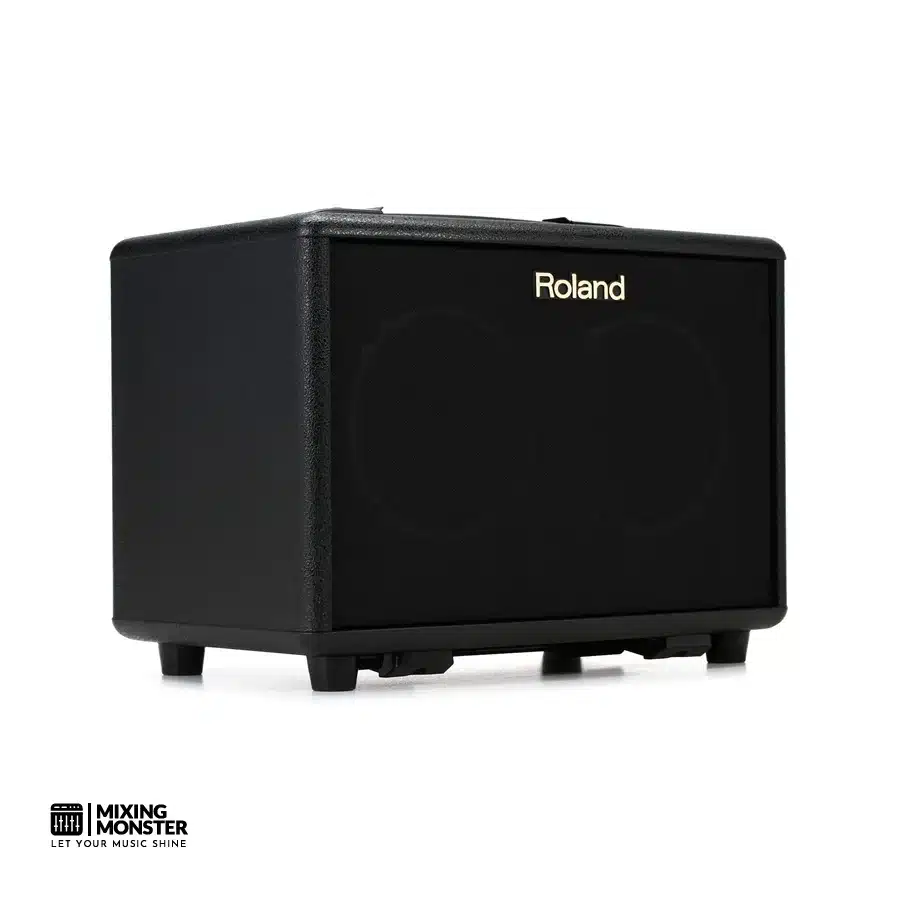
Overview:
The Roland AC-33 is a genuinely portable acoustic amp that surprised us with rich stereo sound from its twin speakers. You can run it on eight AA batteries or plug it in, so it’s a no-brainer for outdoor gigs and street busking.
Dual channels let you plug in both guitar and mic, and built-in effects like reverb, chorus, and ambiance make it feel purpose-built for acoustic guitarists. At just over 13 pounds, it’s easy to carry but still packs enough punch for small shows.
Pros:
- Stereo sound gives your acoustic a real sense of space
- Battery power means you’re not hunting for outlets
- Two channels—sing and play at the same time
- Phrase looper adds creative options for solo acts
- Lightweight and easy to haul around
Cons:
- Speakers can’t match the depth of bigger acoustic amps
- Batteries drain faster if you crank the volume
- Costs more than some other portable amps
- The small speakers limit bass response
Unique Selling Point:
The AC-33 is one of the few amps truly designed for acoustic instruments, offering genuine battery portability that allows you to play anywhere while still enjoying stereo imaging.
Key Benefits:
- Complete Portability – No need for power outlets; play in parks, on the street, wherever you want.
- Stereo Sound Processing – Twin speakers give your acoustic a natural, roomy vibe that mono amps just can’t.
- Integrated Effects Suite – Reverb, chorus, and ambiance are built in, so you won’t need extra pedals for basic enhancement. Sound quality jumps up a notch.
Pricing:
| Average Price | ~ $599 |
Review:
We used the Roland AC-33 both inside and out, and it consistently surprised us with its clarity and ease of movement. The stereo setup really does make a difference—your guitar sounds bigger and more “live” than on mono amps. Battery life reached about 8 hours with good rechargeable batteries at moderate volumes, which worked well for busking.
Dual channels made it easy to sing and play simultaneously. Channel switching is smooth, and the separate EQ for each input made it simple to balance voice and guitar. The looper only gives you 40 seconds, but that’s enough for basic backing tracks or solo layering.
For such a light amp, sound quality is honestly better than expected. The chorus effect adds a nice shimmer, and the ambiance setting can make it feel like you’re playing in a bigger room.
The bass is a little thin, especially when playing percussive or low-tuned material, but that’s the tradeoff for portability.
We’ve hauled this thing around a lot, and it’s held up—no rattles, knobs stayed tight, and jacks didn’t get loose even with plenty of plugging and unplugging.
It does reach its volume limit in noisy outdoor settings, and the battery drains faster when used at full volume. Indoors or in smaller venues, it’s perfect, but for bigger crowds, you’ll need to watch your placement. If you care more about playing anywhere than blasting high volumes, the AC-33 is a solid bet for acoustic performers.
#13 Positive Grid Spark Live w/Battery Bundle
Best For Multi-Instrumentalists, Acoustic Performers, And Portable Jamming
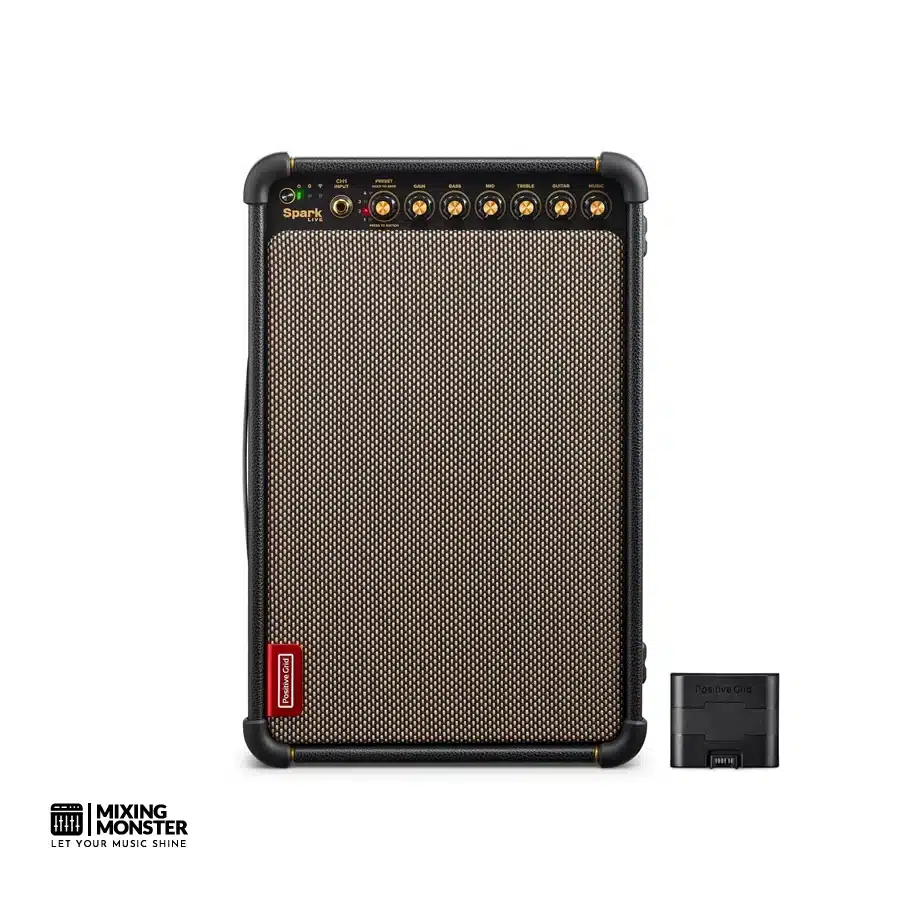
Overview:
The Positive Grid Spark Live really shines as a do-it-all box—guitar amp, mini PA, and Bluetooth speaker all rolled into one. It’s compact but somehow packs in four channels with built-in mixing and effects, so solo acts and small groups both get plenty of mileage.
The battery lasts up to 8 hours, and if you’re into apps, the Spark app unlocks a range of innovative features and virtual gear that’s genuinely fun to explore.
Pros:
- Four-channel mixing handles multiple instruments and vocals at once
- Solid 8-hour battery life makes it super portable
- Loads of connectivity—XLR, quarter-inch, USB, MIDI, you name it
Cons:
- Costs more than a basic guitar amp
- Takes some time to figure out all the mixing features
- Bigger and heavier than simple portable amps, thanks to the PA features
Unique Selling Point:
The Spark Live serves dual purposes by combining the power of a guitar amp with a full PA system, all in one compact box. It’s not just for guitar—plug in bass, vocals, keyboards, whatever, and run them all through the four-channel mixer.
Key Benefits:
- Multi-Channel Versatility – With four separate channels, you can hook up a guitar, a mic, and other instruments without needing an external mixer. Super convenient.
- Extended Battery Performance – The battery lasts long enough for full gigs or marathon practice sessions—no need to hunt for outlets.
- Smart App Integration – The Spark app gives you tons of amp models, effects, and some surprisingly useful AI-driven features to spice up your playing.
Pricing:
| Average Price | ~ $628 |
Review:
The Spark Live impressed us right away by allowing us to run multiple audio sources simultaneously. For acoustic gigs where we need to amplify both the guitar and vocals, the four-channel setup is a game-changer. The built-in mixing tools mean less gear to haul around and a much faster setup.
The battery holds up better than we expected. We got close to the promised 8 hours at moderate volumes, so outdoor jams or rehearsals without power are no problem. Recharging is quick, and so far, the battery has retained most of its capacity even after numerous cycles.
Sound quality is crisp and balanced across all the channels. Sonic IQ’s audio processing ensures everything stays in balance, and it’s impressive how it automatically adjusts the EQ for each input. No more fiddling with frequencies to get things to blend.
All connection options are available, including XLR, quarter-inch, USB, MIDI, and more. Dual line outs make it easy to hook up to larger PAs or record directly from the amp, which is handy for both live and studio work.
The app is a real bonus. You get a ton of amp models and effects, and the AI features actually help you find new sounds or practice smarter. Yes, there’s a learning curve, but once you get the hang of it, the Spark Live covers a lot of ground for anyone seeking a full-featured, portable audio hub.
#14 Roland Cube Street EX
Best For Street Performers, Acoustic Duos, And Mobile Musicians

Overview:
The Roland Cube Street EX is all about portability and solid sound for musicians on the move. It’s battery-powered, pumping out 50 watts through a stereo speaker setup (comprising dual 8-inch woofers and 2-inch tweeters), and features four separate channels for instruments and microphones.
You can run it for up to 20 hours on eight AA batteries, with selectable power modes that further extend the runtime. Built-in COSM amp modeling and effects let you shape your tone on the fly.
Pros:
- Impressive battery life with three power modes
- Four channels for multiple inputs—no sweat
- Stereo sound covers bigger spaces than you’d think
- Light enough to carry without too much hassle
- Built-in amp models sound surprisingly good
Cons:
- Batteries get pricey over time if you use them a lot
- You’ll notice the weight if you have to carry it far
- Bass response is a bit limited for low-heavy genres
- The battery drains faster at high volumes
- Costs more than entry-level portable amps
Unique Selling Point:
The Cube Street EX is unique for delivering true 50-watt stereo power on batteries, plus four independent channels. It’s one of the few that can handle a full small band setup without needing to be plugged in.
Key Benefits:
- Extended Performance Time – Three power modes help you stretch battery life up to 20 hours—great for long busking sessions or all-day events.
- Multi-Channel Flexibility – Each of the four channels has its own EQ and reverb so that you can dial in vocals, guitar, and more without any fuss.
- True Portability – No need for outlets—play anywhere, from parks to street corners, with no worries about power.
Pricing:
| Average Price | ~ $719 |
Review:
The Cube Street EX won us over with its tough build and clever design. After putting it through numerous gigs and rehearsals, it consistently delivered pro-level sound in a portable package. The stereo speakers push a lot more air than you’d expect from a battery-powered amp.
For acoustic duos, those four channels make a huge difference. Each one gets its own EQ and reverb, so vocals, acoustic, and electric all sit nicely in the mix. The COSM amp models sound legit—somehow, they hold up against dedicated guitar amps, which is not what we expected from a portable unit.
The battery life is legit. We got close to the advertised run times in all three power modes. Eco mode is perfect for chill acoustic sets, Max mode cranks enough volume for a crowd, and Normal mode strikes the sweet spot for most gigs.
Yes, it’s not featherweight, but the carrying strap helps, and the balance is good enough that it’s not a problem unless you’re trekking a long distance. We’ve dragged it through city streets and up stairs—no significant complaints. The case has shrugged off a few bumps, too.
Sound remains clear at all volumes, and there’s barely any distortion even when pushed to the limit. The tweeters of the Cube Street EX add clarity you won’t get from most small amps, and the dual woofers do an adequate job with bass. You’ll notice a drop-off in the bass guitar at higher volumes, but honestly, that’s par for the course with this size of amp.
#15 Swiff Audio S100
Best For Professional Musicians Demanding Premium Portability And Tone
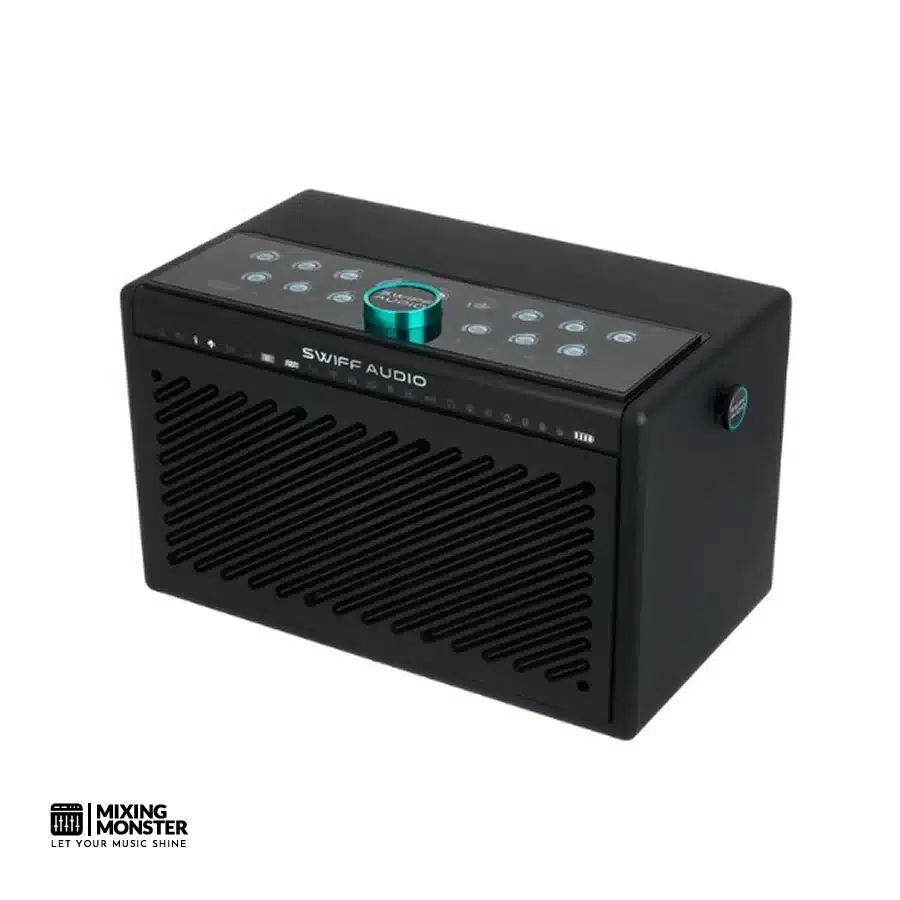
Overview:
The Swiff Audio S100 stands out as one of the most advanced portable amps we’ve come across. It’s designed for guitarists who want a studio-quality sound but need something they can actually carry around.
Swiff packed this thing with digital modeling tech and a battery system that keeps going. It’s sleek and surprisingly light, stuffed with features for practice, recording, or even live gigs.
From the very first strum, we noticed the clarity and dynamic response. That’s not something you get every day from a portable amp.
Pros:
- Exceptional sound clarity and tone modeling
- Long battery life with fast charging
- Compact, lightweight design
- Bluetooth and USB connectivity options
- Wide range of built-in amp models and effects
Cons:
- Premium price point
- Complex interface for beginners
- Slightly limited output volume for large venues
- Replacement batteries can be costly
Unique Selling Point:
The Swiff Audio S100‘s digital modeling engine really takes center stage. It offers a range of amp tones and effects that honestly rival some full-size studio gear, but you can toss it in your backpack.
Key Benefits:
- Professional Sound Quality: Advanced modeling technology delivers rich, authentic tones.
- Connectivity Options: Bluetooth and USB support make it ideal for modern setups.
- Portability: Lightweight yet durable, perfect for travel or compact studio spaces.
Pricing:
| Average Price | ~ $758 |
Review:
When we powered up the Swiff Audio S100, its pristine sound quality hit us right away, the amp’s digital modeling provides a ton of tonal flexibility that you don’t typically see in most portable gear.
We tried it with everything from blues to metal, and it handled it all. The dynamics felt responsive, and the amp simulations sounded convincing enough to prompt a double-take.
Build quality? Absolutely solid. It has a modern, premium look but still feels practical for everyday use.
The control interface isn’t the simplest at first — you’ll probably fumble a bit, but once you get it, the customization is worth it. Bluetooth for backing tracks and USB for direct recording both proved to be handy, making it a versatile tool, whether you’re practicing or producing.
The battery life surprised us, as it lasted through long rehearsals without a noticeable dip in performance. Fast charging’s a real bonus too; we got back to full in less than two hours.
Yes, the price is high, but if you’re serious about your sound, the features and quality speak for themselves.
In actual use, the Swiff Audio S100 proved to be a reliable companion for home practice and smaller live gigs. The sound projection remains clear and balanced, although if you’re playing on a big stage, you’ll want extra firepower.

2. What Is A Portable Guitar Amp?
A portable guitar amp is a compact amplifier designed for guitarists who prefer not to carry a heavy rig. Most weigh somewhere between 5 and 25 pounds, typically featuring a handle or a lightweight design, allowing you to carry them easily.
Battery-powered amps let you play wherever, no outlets needed. Most use rechargeable lithium-ion batteries and last about 4-8 hours per charge.
AC-powered options require plugging in, but typically offer more power and features. We like these for small venues or practice rooms where you’re not moving around as much.
Look for:
- Size: Usually under 15 inches in any direction
- Weight: Under 25 pounds is typical
- Power: 5-50 watts covers most situations
- Inputs: Guitar plus aux, sometimes more
- Controls: Basic EQ, gain, and volume at a minimum
Most of these amps feature headphone outputs for quiet practice, and many have auxiliary inputs, allowing you to play along with tracks from your phone or MP3 player.
Combo amps combine the speaker and amp in one box—eliminating the need for a separate cabinet. It’s just easier.
These days, many portable amps come equipped with digital effects, including reverb, delay, and distortion. Some even have Bluetooth for streaming music wirelessly.
If you’re playing coffee shops, busking, jamming with friends, or want a flexible home practice setup, these amps fill the gap between a big stage rig and just playing through headphones.

3. Essential Accessories To Complement Your Portable Guitar Amp
We always recommend using good cables—a quality instrument cable keeps your signal clean and reduces noise.
Power accessories are essential if you plan to play long sessions. A spare battery pack or power bank can keep your amp alive when you’re nowhere near an outlet.
| Accessory Type | Primary Benefit | Price Range |
|---|---|---|
| Instrument Cable | Clean signal transmission | $15-50 |
| Power Bank | Extended battery life | $25-80 |
| Carrying Case | Protection during transport | $20-60 |
| Footswitch | Hands-free control | $30-100 |
A carrying case keeps your amp safe on the road. Hard cases are best for heavy travel, but a soft gig bag is lighter if you’re running to practice.
Footswitches are great for toggling effects or channels without having to take your hands off the guitar. Makes a difference when you’re in the zone.
Guitar stands help keep your instrument handy and off the floor. Tripod stands fold up small, so they’re perfect for portable setups.
A tuner pedal is a worthwhile addition to your board. Clip-on tuners are quick, but pedal tuners integrate seamlessly into your signal chain and are always ready to use.
Audio interfaces make it simple to record straight into your computer or phone. Just connect your amp’s output and you’re set for tracking ideas or demos.
Extension cords are useful for powering AC-powered amps. We prefer surge-protected power strips for plugging in multiple devices simultaneously, especially during band practice or recording.

4. Portable Guitar Amp Buying Guide
When you’re picking a portable guitar amp, a few things matter more than others. Power output decides how loud you can get and whether your clean tones stay clean when you crank it.
Power Requirements
Battery life varies a lot. Most portable devices run for 4-8 hours, but some last longer. Rechargeable batteries are a better deal in the long run than disposable ones, unless you enjoy buying AA batteries.
Essential Features
| Feature | Importance | What to Look For |
|---|---|---|
| Input Options | High | Multiple input types, aux input |
| Effects | Medium | Built-in reverb, distortion, chorus |
| Connectivity | Medium | Bluetooth, headphone output |
| Controls | High | EQ knobs, gain control, master volume |
Size and Weight Considerations
Portability’s really about finding a balance between sound quality and the amount of hassle you’re willing to put up with. Smaller amps are more straightforward to lug around, but you’ll likely lose some tone.
Honestly, think about where you’ll actually use the thing most of the time—home, street, or stage?
If you’re busking or just moving around a lot, amps under 5 pounds are a lifesaver. Want more oomph? Bigger units—possibly up to 15 pounds—can produce sound that actually fills a space.
Sound Quality Factors
Speaker size really shapes your tone and bass. A 6-inch speaker is fine for practicing at home or in a dorm. If you’re hoping to play out, 8 inches or more will give you that fuller, punchier sound.
Build Quality
Durability’s a big deal when you’re hauling gear. I always check for reinforced corners and knobs that don’t feel like they’ll snap off when I put them in my bag. Metal chassis? Way better than plastic, in my experience.
Price Ranges
You’ll find basic practice amps starting at around $50-$ 100. If you want more features, expect to spend between $100 and $ 300. The fancy, pro-level portable amps? Those can run $300-$ 600, easily.
5. Finding Your Perfect Portable Guitar Amp: Key Takeaways
Power and volume play a huge role in picking the right amp. Battery-powered amps make sense for busking and outdoor jams. If you’re practicing with a band, plug-in models usually give you more headroom and punch.
Weight matters for actual portability. Anything under 10 pounds is easy to grab and go. Once you get heavier, you might want wheels or a decent case, unless you love carrying heavy things for fun.
Definitely try out the sound quality at different volume levels. Some portable amps sound great and quiet, but they start to fall apart when you crank them up. Others hold up and stay clear even when you push them.
Built-in effects can really open up your sound without needing a pedalboard. Reverb, delay, overdrive—those are the big ones. Some higher-end models even come with amp simulations and numerous presets to experiment with.
| Feature | Budget Models | Premium Models |
|---|---|---|
| Battery Life | 4-8 hours | 8-20 hours |
| Effects | 2-5 basic | 10+ advanced |
| Inputs | Guitar only | Multiple instruments |
Connectivity options really boost an amp’s usefulness. USB recording is fantastic for quickly saving riffs or ideas. Bluetooth streaming is handy for jamming along with tracks—no extra cables needed.
It’s helpful to consider your primary use case first. Street performers want different stuff than folks just playing at home. If you’re recording, you’ll appreciate features that live players may not find as important.
Price ranges vary significantly—$50 gets you a basic box, while $500 gets you something of a professional-grade quality. Most people seem happiest with amps in the $150-250 range, where you get a good mix of features and sound without breaking the bank.
Our Top Picks For The Best Portable Guitar Amps
Best Budget Portable Guitar Amps
- Marshall MS-2
- Orange Crush Mini
- Blackstar FLY 3 Mini Amp
- Headrush FRFR GO
- Roland Mobile Cube
Best Midrange Portable Guitar Amps
- Positive Grid Spark Mini
- Yamaha THR5A
- Harley Benton StreetBox-60
- Positive Grid Spark 2 w/Battery Bundle
Best High-End Portable Guitar Amps
- Boss Katana Air EX
- Yamaha THR30IIW
- Roland AC-33
- Positive Grid Spark Live w/Battery Bundle
- Roland Cube Street EX
- Swiff Audio S100

FAQ
1) What features should I look for in the best mini portable guitar amp?
We’d go for 5-15 watts—enough volume, but still easy to carry. Built-in effects like reverb, chorus, and distortion save you the hassle of dragging pedals everywhere.
Multiple inputs are super handy—think 1/4-inch jacks and an aux in for your phone or backing tracks. USB charging and battery indicators are a nice touch for longer sessions.
If you’re gigging frequently, keep it under 3 pounds. Solid metal grilles help protect your speaker from the usual bumps and knocks.
2) Which portable guitar amps offer the best sound quality for acoustic guitars?
Amps with dedicated acoustic presets usually sound the most natural—no weird coloring or boxiness. The Fishman Loudbox Mini and Roland AC-33 are favorites for preserving your acoustic tone.
Anti-feedback controls and notch filters can save you from that dreaded squeal on stage. They’re essential for live acoustic gigs with pickups.
Two channels are great if you sing and play—plug in your mic and guitar at the same time. Singer-songwriters, you’ll love that flexibility.
3) How does battery life compare among top portable guitar amps?
Battery life varies significantly—some amps last 4 hours, while others can last up to 15 hours, depending on the volume level and power draw. The Boss Katana Mini, for example, runs about 7 hours on AA batteries at moderate volume.
Rechargeable lithium-ion models, such as the Positive Grid Spark Mini, typically provide 8-10 hours of battery life per charge, along with USB-C charging for quick top-ups.
Crank the volume, and your battery drains way faster—sometimes 30-50% less runtime if you’re blasting it. Lower wattage amps sip power compared to the big boys.
4) What are the pros and cons of portable guitar amps with Bluetooth functionality?
Bluetooth’s awesome for playing along with tracks from your phone or tablet. It’s convenient for practice or small gigs with backing tracks—no cables to trip on.
Main perks: freedom from cables, easy access to online tracks, and you can usually wander up to 30 feet from your device before it cuts out.
On the downside, you may experience some audio lag, and Bluetooth can drain the battery faster if left on. Occasionally, amps will drop the connection if you use them for hours at a stretch.
5) What are the latest innovations in portable guitar amp technology?
App integration is a significant leap—amps like the Positive Grid Spark let you control everything from your phone, including effects, presets, amp models, and more.
Some portable amps now double as USB audio interfaces, allowing you to record directly to your laptop. That’s a game-changer for writing or demoing songs on the fly.
And amp modeling keeps getting better—now you can get classic Fender, Marshall, or Vox tones in a tiny box that fits in your backpack. Wild, honestly.
6) Can you recommend a rechargeable guitar amp that's easy to carry around for gigs?
We’d go with the Roland Cube Street EX. It features a dual-channel setup and produces up to 50 watts, which is more than enough for most small to mid-sized gigs. The built-in rechargeable battery typically provides around 6-8 hours of use, and the shoulder strap makes it easy to carry from place to place.
The Fishman Loudbox Performer is another solid choice. It’s rocking 180 watts and works on rechargeable power, too. Yeah, it’s not exactly featherweight—definitely heavier than those tiny amps—but the sound quality is just on another level if you’re playing bigger rooms or want that pro feel.
If you’re looking for something extremely lightweight, consider the Boss Katana Mini. Weighs barely over two pounds, runs on AA batteries, and you can literally toss it in your gig bag.
It’s remarkable how much volume you can get out of something that small, making it perfect for busking or coffee shop sets.

